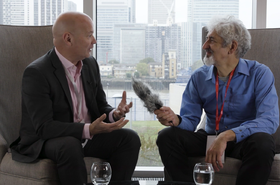During our DCD>Talks, we have the opportunity to get to know companies on a more intimate level – to learn their motivations and their goals.
Iceotope takes on the task to innovate liquid cooling –- and doing so in a way that minimizes waste.
We sat down with David Craig, CEO for Iceotope Technologies Ltd to talk about Iceotope’s approach.
“Liquid cooling is a many-headed Hydra. At the simplest level, well-deployed, you're going to save a lot of space, you're going to save a lot of energy, and you're going to save a lot of water. But most infrastructure, in the technology of the data center, just introduces a constraint to be managed.
“One of the things that's unique about us is we go beyond cooling, and protection, we get monitoring and serviceability enhancements. We actually become a platform, we become a whole solution that can live both in the data center and outside. So we're no longer constrained but a really enabling technology.”
A liquid-based approach to cooling has many benefits: reduced emissions, lower costs, and less power consumption. But the method brings with it complexity and apprehension –-- not least because of the unsubstantiated worry of getting water on the hardware (there are electronics-safe liquids available now).
Because of this complex nature, when it comes to the design of liquid-cooling systems, there are many different approaches and considerations that need to be taken.
“I think it [the technology] was absolutely right to be rack-based, but the implementation wasn't scalable, and it certainly was full of risks that businesses couldn't understand how to properly manage at that time. If you look at data centers as organisms that are made up of many moving parts, there must be exercises to manage risk. More than anything, you've got to be safe and secure against downtime.
“Our approach was to say, let's look at this landscape, and not just look at the technology. You need a technology solution that does the job, but it's got to be scalable, it's got to be familiar, it's got to be capable of being adopted in retrofit, and then have future longevity. It's got to have a business model that allows it to scale, as well as on the technology side.
“We went away and we looked at both bathtub immersion and cold plate and drew the circle of a Venn diagram around the best bits of both. Then we came to this, what we call chassis-level precision immersion. By being chassis level, you've got that benefit of being able to scale down to the unit of one, and up to many.
“We've got a set of IP, which can be deployed in a myriad of configurations. So you get a core platform technology that you can configure to suit anything. It's not just servers and GPUs, but spinning disks, etc, and because we're in that sealed chassis, we can build it anywhere. You can use exactly the same solutions at the Edge of the network as you do in the data center. What we've done is deliver something which, as a technology, has fewer barriers to entry.”
At the end of the day, Iceotope is looking to make sustainability accessible and simple. Watch the full episode to learn more about Iceotope’s solutions, and David Craig’s perspective on ubiquitous computing.




